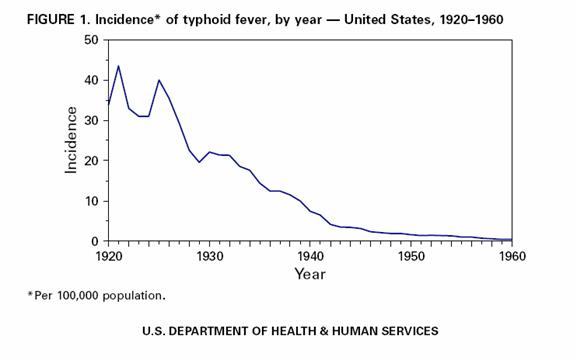CDC Features
National Drinking Water Week is May 4-10
<< Back
Figure 1: Incidence of Typhoid Fever, 1920-1960. With the implementation of disinfection methods of drinking water, there has been a drastic decline in cases of typhoid fever in the United States. In 1920, the incidence of typhoid fever in the U.S. was 33.8 per 100,000 population, which was a decrease from approximately 100 per 100,000 population in 1900. In 1930, the incidence was less than 20 per 100,000 population; in 1940, it was less than 8 per 100,000; and by 1960 the incidence of typhoid fever in the U.S. was less than 1 per 100,000. Image Credit: Robert Tauxe.
Page last reviewed: May 5, 2008
Page last updated: May 5, 2008
Content source: Division of Parasitic Diseases, Division of Foodborne, Bacterial and Mycotic Diseases, Division of Emergency and Environmental Health Services, Division of Environmental Hazards and Health Effects, Office of Global Health at NCEH/ATSDR, Agency for Toxic Substances and Disease Registry, National Center for Zoonotic, Vector-Borne, & Enteric Diseases, National Center for Environmental Health, National Center for Chronic Disease Prevention and Health Promotion
Content owner: National Center for Health Marketing
URL for this page: www.cdc.gov/Features/DrinkingWater
Page last updated: May 5, 2008
Content source: Division of Parasitic Diseases, Division of Foodborne, Bacterial and Mycotic Diseases, Division of Emergency and Environmental Health Services, Division of Environmental Hazards and Health Effects, Office of Global Health at NCEH/ATSDR, Agency for Toxic Substances and Disease Registry, National Center for Zoonotic, Vector-Borne, & Enteric Diseases, National Center for Environmental Health, National Center for Chronic Disease Prevention and Health Promotion
Content owner: National Center for Health Marketing
URL for this page: www.cdc.gov/Features/DrinkingWater


